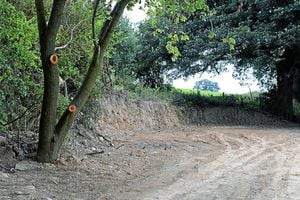Ancient monument Offa's Dyke no match for bulldozers
For 1,200 years Offa's Dyke has marked out the ancient boundary between Mercia and rival Welsh kingdoms.

The 177-mile structure is Britain's longest ancient monument and runs almost uninterrupted from the Shropshire/north Wales border to the Wye Valley.
Although it has weathered the centuries, it has turned out to be no match for a modern bulldozer.
Several hundred metres of the dyke on the edge of Shropshire was destroyed last week.
Experts believe the ramparts were flattened by a bulldozer or earthmover and the soil, which has lain undisturbed since the 8th century, was probably used to fill in the ditch alongside.
Police and the Welsh heritage organisation, Cadw, are continuing to investigate how the earthwork, alongside the A5 north of Chirk, came to be flattened.
Wrexham County Borough Council has now issued an interim Tree Preservation Order on land close to the damaged monument.
Pinned to the trunk of one of the trees, the order under the Town and Country Planning Act prohibits anyone from cutting down, topping or lopping any of the trees on the site.
A spokesman for the authority said the order had been made to stop a possible future threat.
The council will now decide if the order should be confirmed and be made permanent. People have until September 16 to comment on it. Last week's damage was reported to the Offa's Dyke Association.
Member Jim Saunders, based in Knighton, immediately contacted Cadw, which has responsibility for ancient moments in Wales, which in turn notified the police.
Mr Saunders said it was too early to say whether the dyke would be rebuilt. He added: "The ditch could be dug out but the dyke has been destroyed now it will never be the same again."





